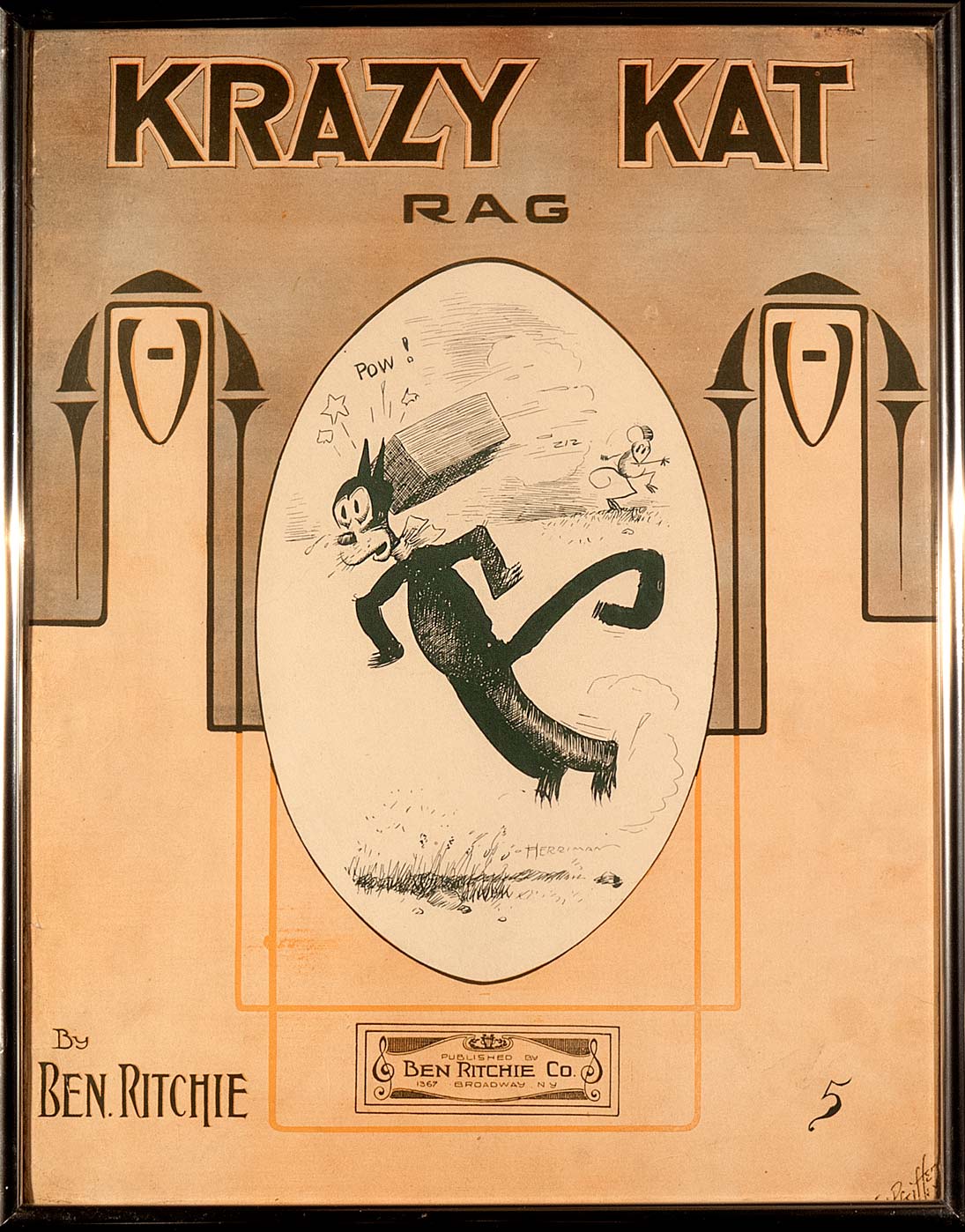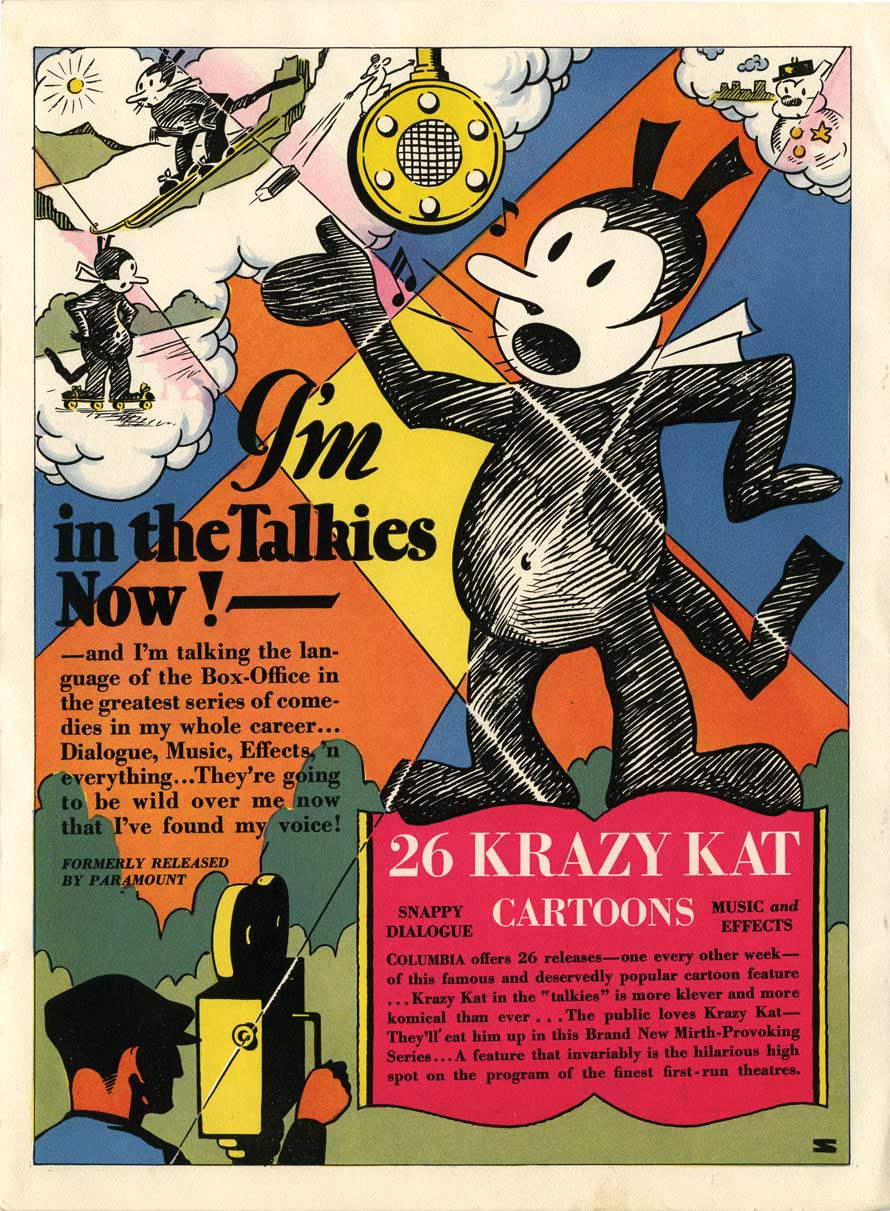KRAZY KAT
All Photographs and Copy are Coryright MEL BIRNKRANT
Some of the imagery is Copyright The Walt Disney Company
Greetings from
THE MEL BIRNKRANT COLLECTION
A Guided Tour of
George Herriman is considered to be one of the greatest comic artists of all time. The profound mystique of his masterpiece, “Krazy Kat” has defied description, although many high-toned writers, among them the poet E. E. Cummings, have praised, and tried to analyze its curious mixture of surrealism, slapstick comedy and poetry. It has also defied translation into the world of film, and toys as well.
William Randolph Hearst, owner of The New York Evening Journal, where the strip first appeared, in 1913, absolutely loved Krazy Kat. And his personal liking for it kept this never wildly popular strip alive, until Herriman died in 1944. The unconventional love triangle it depicts, between "Krazy Kat", a masochistic idealistic Kat, of indeterminate gender, a sadistic brick hurling mouse,”Ignatz” that she/he adores, and “Offissa Pup” a well-intentioned agent of the law in “Coconino County”, who is in love with Krazy, and has assumed the role his/her protector, flew over the heads of most of the public. Much like "Peanuts", later on, Krazy was directed at adult readership. But, unlike Charlie Brown and Snoopy, for whom all that changed with the advent of TV, Krazy Kat never caught on with kids. Therefore, there were few toy products made.
As a licensed property Krazy had two lives, not nine, two distinctly different manifestations of the Kat's complex personality. The first took place in 1916 when a series of dolls appeared. These were as much adult novelties as they were for kids, and limited popularity, as well as the fact that 1916 was 97 years ago, make these dolls extremly rare, today. Here is an ad that appeared in the November issue of Playthings Magazine, heralding their introduction, in limited supply, just in time for Christmas. “THE BIG SKREAM, Kraziest Kat You Ever Looked At”, it reads. Esoteric excerpts from the strip run down the borders of the page.

I’ll never forget acquiring my first Krazy Kat doll. The way It came to me was almost mystical. The day before I was heading up to the May opening of the second year of Brimfield, I got a call from a toy dealer who offered me a felt Krazy Kat doll. I had never heard of such a thing, but he described it fairly well. The price was a ridiculous, 150 dollars. In 1969, that price was totally outrageous. It might as well have been 150 thousand. Naturally, I said, “No thank you”.
The following morning, found me racing through the fields of Brimfield, just as the dealers were beginning to unpack. Suddenly, I saw it, sticking up from the tall grass, something skinny and black, a tail with a bent end! I knew, instantly, what it had to be! Lying face down in the weeds, was a 12 inch doll of Krazy Kat. The price was one dollar! Needless to say, I paid for it, as fast as lightening, trying not to openly squeal with glee. I was a happy kitty! It was, as if, the dealer who called the day before, did so, soley, to teach me how it identify this doll. It was the 1916 version, the smallest of four different sizes. Here he stands, on the far left side of the showcase, below. These early dolls all have stump-like hands, feet, tail, ears and nose. The eyes are merely holes in the white felt face. Through a middle hole, there protrudes a long stump of a nose.



Krazy Kat was never “all the rage”, and his/her brief popularity, was due, largely, to the fact that Krazy was the only Kat around. It came to an end, abruptly, when "Felix", a much more user friendly cat, blew into town.
Around 1930 Krazy Kat came back to life again, sort of like a feline zombie, resurrected from the dead, thanks to the advent of "sound". Now, his persona changed, and he became decidedly male, with a voice like Mickey Mouse, and much of Mickey's personality, as well. This was a lame attempt to generate a property that could take advantage of, and compete with, the popularity of Mickey. This time around, Krazy had two things going for him, name recognition and sound. He was introduced in a series 26 new sound cartoons, distributed by Columbia.

So, once again, new dolls appeared. These were made by Knickerbocker. Curiously, although, designed more in the going style of 15 years later, they bore a stylistic kinship to the earlier version, particularly the strange eyes of the 1916 dolls. In both incarnations, the eyes consisted of nothing more that holes in the white felt fabric of the face, with a layer of black fabric, underneath. And the nose still emerges from a hole in the middle of his face. There are three sizes of these in the showcase. The two larger ones have stuffed hands and the smaller one, as well as the ignatz dolls, have hands that are flat, cut out of felt. The 1916 dolls came in a variety of colors, while the later ones were only black and white. Knickerbocker also made some dolls of Ignatz, often mistakenly identified as Mickey by inexperienced dealers and collectors, alike. There are three of those in the showcase, too.
My favorite doll artist, Joseph Kallus also designed and manufactured (Cameo Doll Company) a fabulous Ignatz doll. It can be seen here with its delightful original box. Ignatz’s arms, legs and tail are electrical wire, while his head and body are cast in composition. Jaymar also made a black and white wood jointed mouse that is often erroniously thought to be Ignatz by wishful thinkers, who are not in the know. In its original box, it is simply called "Mouse".

J. Chein & Company made a group of Krazy Kat toys, as well. Here is the smallest version of the 1930s doll, holding a Krazy Kat sparkler by Chein. Another Chein toy is Ignatz riding on a tricycle. The showcase also contains two wood jointed Krazy Kat dolls by Chein, with toothy grins. Chein also made two "Krazy Kat" windup toys which you will not find in my collection. The advent of sound quickly wiped silent Felix off the silver screen, when sound cartoons became the rage. So Chein recycled their Felix windups by simply incising Krazy Kat’s name. .These were merely Felix the Cat toys, relabeled as Krazy Kat. The toys, themselves, remained the same.

On the back wall of this showcase is a rare Einson Freeman Krazy Kat mask. They also made a matching paper mask of Ignatz, which I have never seen. All in all, the contents of this single showcase contains all the Krazy Kat items, of which I am aware, except for a wooden Chein pull toy of Krazy in a locomotive that I had many opportunities to buy, but always at a price that seemed too high. Apart from that, and other color variations of the early dolls, blue, purple, green, etc , that’s. pretty much. all that was made.
There must have been other items, as well, that time erased. One surviving remnant of Krazy’s heyday is this sheet music, “The Krazy Kat Rag”, with cover art that incorperates an early drawing by Herriman
More faithful to the spirit of the original was a 1922 Ballet, with music by the American composer John Alden Carpenter. The score is very pleasant. If you are curious, you can hear it, HERE. Herriman was fully and actively involved with this production. The piano score was handsomely published with Herrmann’s own drawings, illustrating the storyline.


George Herriman, himself designed the costumes and created the scenery, which ingeniously replicated the ever changing backgrounds of the strip, by being painted on a long piece of canvas suspended on large rollers, permitting it to scroll across the stage, throughout the thirteen minute performance. Herriman actually painted this moving panorama, himself. Forty five years ago, my friend, Richard Merkin showed me a copy of the original program from the actual production. It was full of amazing photographs. I have tried in vain, many times, to find a copy of it on line, or on eBay. I did discover one small photo that is, most likely, from that program. It indicates the degree to which the bulky costumes dominate. “Swan Lake”, this aint!
Last of all, I do have one fabulous Krazy Kat item, an original painting by George Herriman. He was known to do paintings, like this one, in colored ink, and give them as gifts to friends, already framed. He also used a unique style of frame. Orange and green was a favorite color scheme for these. That is why I posted this art extra-large, so I could include the frame. The painting was a gift to the actor Roland Young, who played Cosmo Topper in the movies, “Topper”, “Topper Takes a Trip”, and “Topper Returns”. The situation the art depicts is typical Krazy Kat. Krazy, Ignatz and Offissa Pup, lean against some potted cactus plants in the surreal landscape of Cckonino County, gazing at a brick that lies in the road before them. The dealer who sold me this, immediately regretted parting with it, and tried to buy it back again, within a week. I think he did some research on the price, which, incidently, wasn’t cheap, and decided that he, nonetheless, made a mistake.

There were many attempts to adapt Krazy to the movies. All of them missed the mark. The complex relationship between Krazy and Ignatz was never fully explored, and in the later sound cartoons, it was ignoored, and eliminated, altogether, as Krazy assumed the role of Mickey Mouse. His most distinguishing feature, now, was the fact that his ears were small and square, while Mickeys ears were large and round. Herriman, apparently, was not involved with any of these cinematic adaptations.
In the early 1970s, I corresponded with a pioneering comic art collector, Murray Harris. Murray began collecting comic character art, when he was 5 years old, well before anybody. The most unique aspect of his collection was the fact that he had been sending blank post cards to all the famous comic strip artists, all his life, and they sent back their autographs, often accompanied by a drawing. In 1973, Murray commissioned a Krazy Kat sculpture in bronze. It was intended to be a limited edition of 25. They were to be cast, one at a time, as orders came in. I thought the sculpture was terrific, and ordered one, immediately. So early, that I got sculpture number one, which was already done, so, I didn’t have to wait to have a copy made. I don’t believe the run was ever completed. I know he sold, at least, one more, for sure, as it was purchased, at my urging, by Harry Kislevitz. The inscription reads: “Apologies to Herriman Deter & Richard Myer for Murray A. Harris 1/25 (meaning number one of 25) 1973”.

















